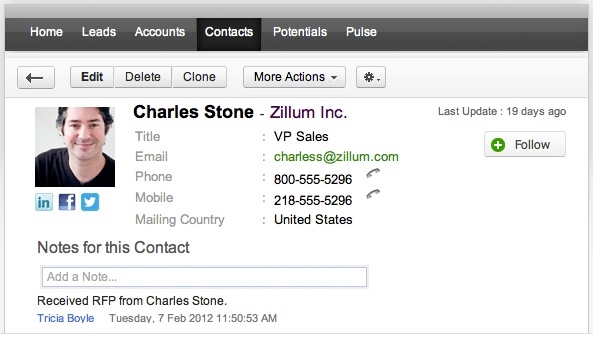
Image: Zoho.com
Like many small businesses, SixEstate has been working at wedding our Content Management System (CMS) and our Customer Relationship Management (CRM) software into one full-circle marketing marriage. It’s not easy, but when you get there, it’s as close to Nirvana as you can get this side of Seattle.
Content Management Systems
Through your CMS, you offer prospects a buffet of choices, including blog posts, newsletters, whitepapers, e-books, presentations, videos, apps. In exchange, what you ask for, to use a phrase no longer fashionable, is permission to communicate with the consumer.
That permission comes in a variety of ways. The consumer can consent to your terms, allowing you to track them or interact with them, within boundaries adjustable by both the user and the tracker.
Permission comes through an email address used to sign up for a newsletter. Or the email address might be obtained through a request for a file, such as a price list or whitepaper. Very often, email access is granted before a prospect considers allowing phone access, text access, or access through a social network.
By filling available channels with quality content, marketers create a network that results in qualified prospects — a lead-generation network, as it’s called today.
Once someone becomes a lead, what happens next is critical. In many content management systems, what happens next is nothing. The person’s email address may not even be harvested properly. No profile is built from the address. No human being follows up.
Responses to lead-generating content can be even worse than neglect. I’ve subscribed to opt-ins that turn out to be nothing but mechanized content drips that terrorize subscribers with email sales pitches until they finally opt out.
Businesses have a hierarchy of goals for their websites and content management programs. They include:
- Increasing traffic: Okay, more people are coming. How is that helping?
- Improving search engine rankings: We love to outrank the competition, but why? At what cost?
- Growing sign-ups: Now we’re getting somewhere. How many people cross the threshold and cease to be anonymous?
- More customers: In high-volume businesses, you quickly find you can convert a reliable percentage of sign-ups to customers. Increase the sign-ups and you increase sales. That’s the Nirvana all business owners hope for: a machine that will turn prospects into customers, and customers into repeat customers.
Enter CRM
Customer Relationship Management (CRM) kicks in at most companies once there is a sale and someone becomes a customer. But it should kick in when the Content Management System (CMS) generates a lead. This is one of the hiccups keeping companies from uniting their CMS and CRM: leads and prospects are not put into CRM.
For CRM to merge with CMS, CRM has to start tracking leads and prospects, not just customers. CRM has to convert viewers into prospects and customers, paying very close attention to how and why people jump the threshold to first become a prospect and then a customer.
If a potential customer is lost in the hand-off between CMS’s lead-generating prowess and CRM’s lifetime tracking system, companies will convert only a fraction of the prospects they’ve worked so hard to connect with. Getting this linkage right adds leverage to your marketing spend.
Adventures in Zoho
When you merge CMS and CRM well, you get OMG. For example, SixEstate switched to Zoho for our CRM, and now uses that exclusively for contact management. It’s similar to Salesforce.
We prefer Zoho tremendously to keeping contacts in Entourage, Gmail, Google Contacts, Excel, or our own custom contact database program. Contacts are stored on the cloud and available to everyone on the team. Dashboards make it easy to follow prospects and clients, in some cases documenting every interaction overs years. Ideally, the database includes everyone who touches the business in any way: suppliers, customers, prospects, employees, shareholders — even media contacts.
We hook Zoho’s CRM up to MailChimp for our newsletter. MailChimp automatically synchs with Zoho, pulling new subscribers onto the MailChimp list and unsubscribing contacts that had delivery problems. A note in the contact’s Zoho file documents any changes made by MailChimp.
Great content plus great follow-up equals a growth business. If you feel weak in either content or follow-up, let us help. We are unlocking the secrets of content marketing and customer relationship management for ourselves and our clients. When the two are combined, the result is capable of transforming your business into blissness.